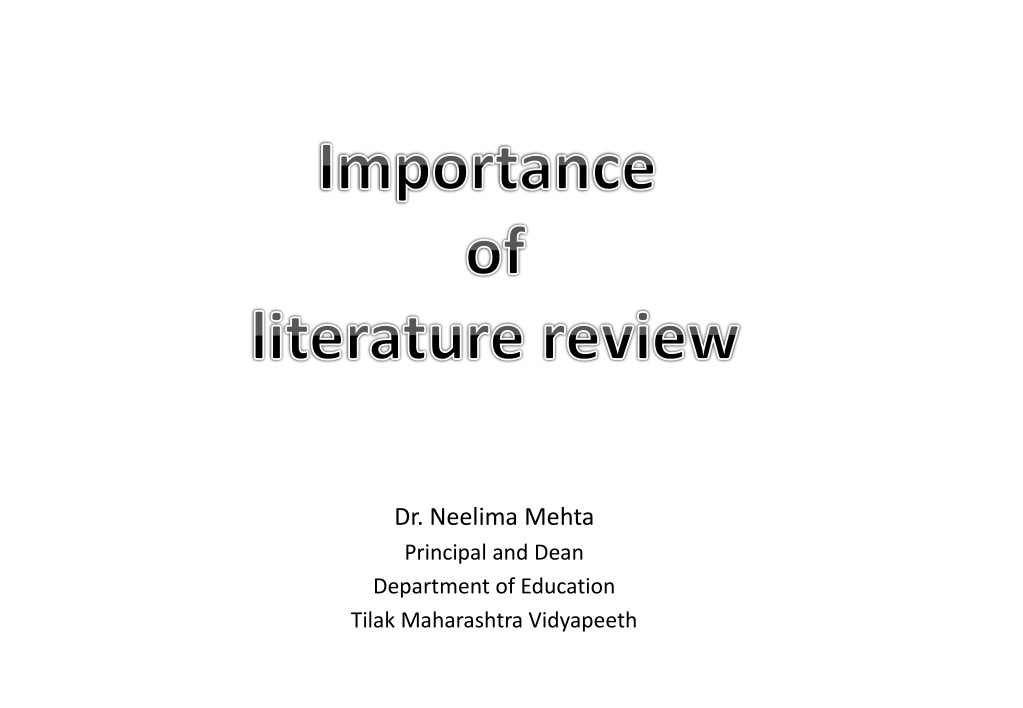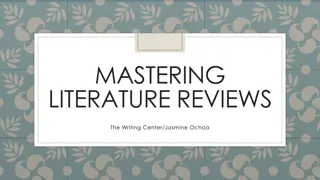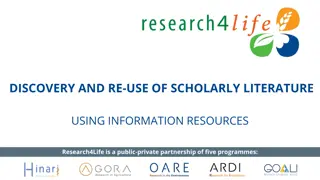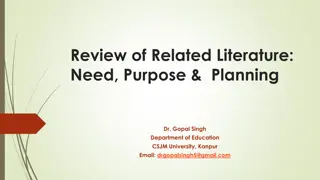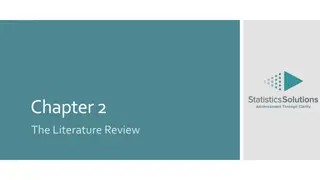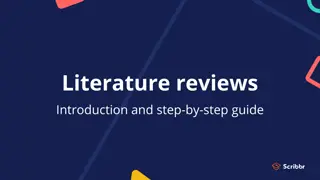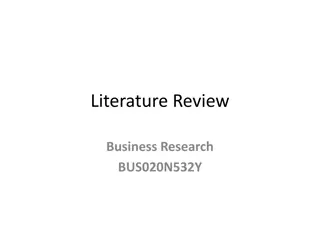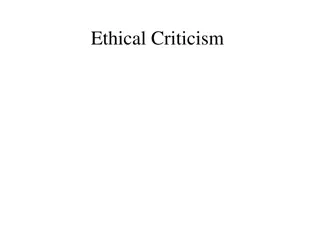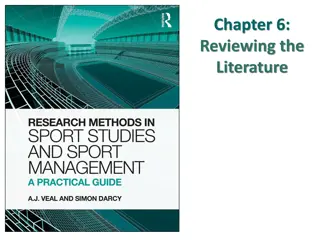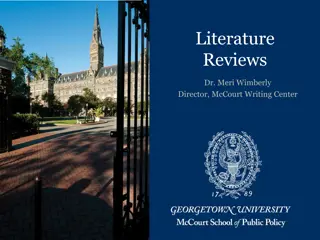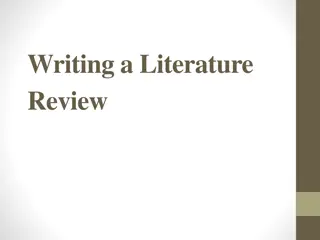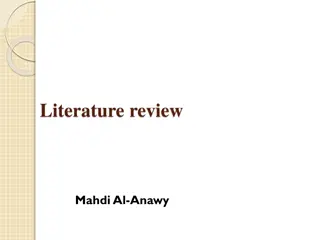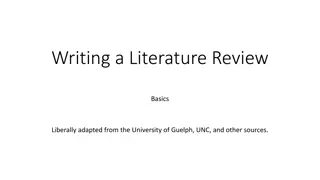Importance of literature review
A literature review is a critical component of any research endeavor, providing a comprehensive analysis of existing knowledge in a particular field. This review helps in clarifying conceptual issues, understanding research design, persuading examiners, and contributing new insights to the subject area. It is crucial to conduct this review at different stages of research to ensure its relevance. Creswell's steps, such as identifying key terms and familiarizing oneself with databases, are essential for conducting a thorough literature review.
Download Presentation

Please find below an Image/Link to download the presentation.
The content on the website is provided AS IS for your information and personal use only. It may not be sold, licensed, or shared on other websites without obtaining consent from the author.If you encounter any issues during the download, it is possible that the publisher has removed the file from their server.
You are allowed to download the files provided on this website for personal or commercial use, subject to the condition that they are used lawfully. All files are the property of their respective owners.
The content on the website is provided AS IS for your information and personal use only. It may not be sold, licensed, or shared on other websites without obtaining consent from the author.
E N D
Presentation Transcript
Importance of literature review Dr. Neelima Mehta Principal and Dean Department of Education Tilak Maharashtra Vidyapeeth
What is a Literature Review ? According to Creswell (2005) , a review of the literature is a written summary of journal articles, books and other documents that describes the past and current state of information, organizes the literature into topics and documents a need for a proposed study. (pp.79) Literature review is the presentation, classification and evaluation of what other researchers have written on particular subject. 2
The Literature Review The review of the literature is defined as a broad, comprehensive, in - depth, systematic , and critical review of scholarly publications, unpublished scholarly print materials, audiovisual materials, communications. Merriam (1988) define an interpretation and synthesis of published work and personal literature review as 3
How Literature Review will help you in your proposed research ? It will clarify the conceptual issues of your research related area. It will help you to learn about research design for your research. It is an opportunity to persuade your examiner that your research is relevant worth doing. It will give you insight to contribute something new in your subject area. 4
Three stages at which a review of the literature is needed 1. An early review 2. Review during the period of your research. 3. Review at the stage of preparing your final report 5
Creswells 5 steps to conduct a Literature Review Step 1 : Identify Key Terms Extract key words from your title (remember, you may decide to change the title later) To identify key terms use Thesaurus of ERIC. The site address is www.eric.ed.gov 6
Step 1 : Identify Key Terms ( contd) Familiarize yourself with online databases Using relevant database. 1. Start with a general terms from the database thesaurus. 2. Redefine your topic if needed. 3. Identify landmark or classic studies and theorists. 7
Step 2 : Locate Literature Use academic libraries, do not limit your search to an electronic search of articles. Use primary and secondary sources. A primary source is research reported by the researcher that conducted the study. A secondary source is research that summarizes or reports findings that come from primary sources. 8
Step 2 : Locate Literature (contd) It is best to report mostly primary sources (p.82). Search different types of literature: summaries, encyclopedias, dictionaries and glossaries of terms, handbooks, statistical indexes, reviews and syntheses, books, journals, indexed publications, electronic sources, abstract series, and databases. 9
Step 3: Critically Evaluate Selected Literature Rely on research Journal articles published in national journals Prioritize your search : first look for refereed journal articles, then, non-refereed articles, then books, then conference papers, dissertations and theses and then papers posted to websites. Look for research articles and avoid as much possible opinion pieces Blend qualitative and quantitative research in your review. 10
How to read research article critically (An appreciation of Strength, Weakness and Limitations) Identify research aim / questions ? Identify nature / type of study. Identify ontological position, epistemological and methodological assumptions. Is researcher s value position explicit ? Identify location, date sample method used. 11
(Contd) Examine use of theory, deductive ? Inductive ? Are analysis, method clearly explained ? Are conclusions appropriately supported by evidence ? What are the implication for policy and practice? 12
Step 4: Organize the Literature 1. Create a file or abstract system to keep track of what you read. Each article you read should be summarized in one page containing - Title (use APA to type the title so that you can later copy-paste this into the References section of your paper) Source: journal article, book, glossary, etc. Research problem: one or two lines will suffice. 13
Research Questions or Hypotheses Data collection procedure ( a description of sample, characteristics can be very handy as well) Results or findings of the study 2. Sort the abstracts into groups of related topics or areas which can then become the different sections of your review. 14
(contd) 3. Take notes: 1.Decide on the format in which you will take notes as you read the articles. 2.Define key terms 3.Note key statistics that you may want to use in the introduction to your review. 15
4. Note emphases, strengths & weakness. 5. Identify major trends or patterns. 6. Identify gaps in the literature 7. Identify relationships among studies 8.Keep your review focused on your topic. 9.Evaluate your references for currency and coverage. 16
Step 5: Summarize the Literature in table or concept map format Galvan (2006) recommends building tables as a key way to help you overview, organize, and summarize your findings. 1. You can create the table using the table feature within Microsoft Word 2. You can create it initially in Excel. 3. The advantages of using Excel is that it enables you to sort your findings according to a variety of factors (e.g. sort by date, and then by author; sort by methodology and then date, summary of research result) 17
Structure of the Literature Review : There is not one ideal structure for your literature review so talk to your guide about this . Consider whether you wish to organize your literature review chronologically, thematically, by development of ideas (or a combination of these) Make sure that you always explain your structure for your structure for your reader and have a clear narrative. 18
Synthesize the literature prior to writing your review Using the notes that you have taken and summary tables, develop an outline of your final review. The following are the key steps as outlined by Galvan (2006:71-79) 1. Consider your purpose before beginning to write. 2. Consider how you reassemble your notes 3. Create a topic outline that traces your argument. 4. Reorganize your notes according to the path of your argument 19
5. Within each topic heading, note differences among studies. 6. Within each topic heading, look for obvious gaps or areas needing more research. 7. Plan to describe relevant theories. 8. Plan to discuss how individual studies relate to and advance theory. 9. Plan to summarize periodically. 10. Plan to present conclusions and implications. 11. Plan to suggest specific directions for future research. 20
Writing the review 1. Importance of the topic. 2. Distinguish between research finding and other sources of information. 3. Indicate why certain studies are important. 4. If you are commenting on the timeliness of a topic, be specific in describing the time frame. 5. If a landmark study was replicated, mention that and indicate the results of the replication. 6. Discuss other literature review on your topic. 7. Justify comments such as, no studies were found . 21
8. Avoid long lists of nonspecific references. 9. If the results of previous studies are inconsistent or widely varying, cite them separately. 10. Near the beginning of a review, state explicitly what will and will not be covered 11. Specify your point of view early in the review: this serves as the thesis statement of the review. 12. If your topic teaches across disciplines, consider reviewing studies from each discipline separately. 13. Write a conclusion for the end of the review. 22
Referencing Provide full details of all sources cited in the dissertation Should include published book or articles, book chapters, technical reports, web sources, etc. List alphabetically by author name (name of first author in the case of work with co-authors) Make sure you understand the university regulations on plagiarism Consult your department guidelines for more on referencing style 23
5 minute self test Read the following statements and identify if they are true (T) or false (F). 1. T / F A literature review should refer to all key literature in your field of study. 2. T / F A literature review should always identify a need for further research. 3. T / F A thesis statement is important to guide research for a literature review. 4. T / F A research question is important to guide research for a literature review. 5. T / F Literature which is not related to your research objective should be discarded. 6. T / F There is one widely recognized, standard structure for a literature review. 24
Answer key 1 ---- F 2 ---- T 3 ---- T 4 ---- T 5 ---- T 6 ---- F 25
References 1) Creswell, J.W. (2005)Educational Research : Planning, Conducting and Evaluation Quantitative and Qualitative Research. 2) Toylor, D. (2001) writing a Literature Review http://www.utaranto.co/hswriting/lit-review.html 3) APA Documentation VW-Madison Writing Center Writer s Handbook. http://writing.wisc.edu/Handbook /Review of Literature.html 26
4) How to prepare literature review www.le.ac.uk 5) Guideline for writing literature review http://www.duluth.umn.edu/~hrllis/guides/researchin g/litreview.html 6) Thinking about Research and Research Quality in you academic work Oxbridge. 7) www.eric.ed.gov 27
Thank you ! 28
